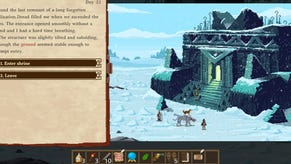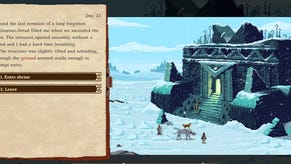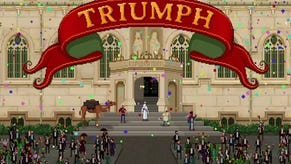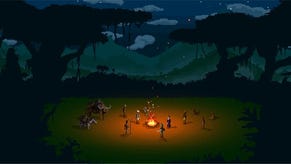Wot I Think: The Curious Expedition
Idol clicker
The Curious Expedition [official site] is a turn-based game of exploration and exploitation in which you control one of several historical characters, wandering the world in search of fame and fortune. After a long trek through the wildlands of Early Access, it has emerged as a complete game today. But does it belong in a museum or should it have been left to rot in the ground? Here's wot I think.
A hundred days into what was to be our last journey together, everything went horribly wrong. We'd lost companions before - to fever, to hunger, to aggressive wildlife - but this was different. Seizing some sacred treasure from a shrine we unleashed what can best be described as The End Times. We'd triggered localised unpleasantries before, including firestorms, floods and the replacement of entire vibrant ecoystems with life-sapping desert, but never anything like this. It was a void, consuming the world itself and leaving nothing in its wake.
We hopped into our hot air balloon, headed back to London and didn't mention the incident to anyone at the explorer's club. Let us pray that the awful nothingness that spilled out of that shrine is not growing still and that it will never reach these shores.
The Curious Expedition is a game about trekking across procedurally generated maps, searching for treasure and leaving a trail of destruction wherever you go. Sure, it's possible to tread softly and treat those you meet with respect, but the game really shines when you're skipping from one catastrophe to the next with a mule-load of treasure in tow.
I love it. If you remember Strange Adventures in Infinite Space fondly, it scratches a similar urge. It's a coffeebreak game, and I mean that as a very strong compliment. You can play through an expedition in a few minutes, though you could also spend much longer agonising over decisions and trying to make the best of every bad situation. With its emergent narratives and threats, it has something in common with Spelunky and the old Escape From Atlantis boardgame as well as some recent roguelites. I'm not going to tell you about everything that there is to find because expeditions are all about discovery after all, so keep that in mind as you read. There is more to the game than jungles and shrines.
A full playthrough comprises six expeditions, usually increasing in difficulty from one to the next though you do have a choice of locations (randomly selected) and can attempt to stick to better-trodden paths. Once you've arrived at your destination, you uncover the map by exploring. Time waits for you as you plan your next move, and you can always see exactly how much Sanity a particular journey will cost.
Sanity is your main resource, which is a little odd, almost seeming like a leftover touch of thematic flavour from a time when the game focused more on the horror of the unknown. There are still dark corners of the Earth (and possibly beyond) to risk your life and emotional wellbeing in, but The Curious Expedition is more King Solomon's Mines than Mountains of Madness. At least for the most part. Lovecraft is a featured character after all.
Let's get back to resource management and movement though. Sanity is the only resource you'll need to keep an eye on, though the amount that is spent for each terrain tile is dependent to an extent on the equipment that you have. Machetes allow you to cut through thick jungle, decreasing travel time and therefore decreasing sanity expenditure. Use of items in that fashion is automatic and that's typical of the excellent interface – this is a game that allows you to focus on doing interesting things rather than forcing you to figure out how those things are done.
And so you wander, fairly directionless at first, perhaps sticking to easy terrain, or maybe trying to reach the question marks that appear on the fringes of the areas you're covering. These could be anything from abandoned camps to native villages, all of which lead to short text-based encounters. Villages are among the most interesting places because the reception your party meets depends on their reputation in the area, which can rise or fall depending on your actions across the entire map. Plunder shrines and other sacred places, and you might find yourself in hot water.
If your reputation really hits the rocks, bands of warriors will travel across the map trying to hunt you down. There are also animals in most regions and the way these encounters work is clever. Every group of creatures or people has a red radius, within which there's a percentage chance that they'll become aggressive and attack you. If that happens, they attack first in dice-base combat (weapons and characters have their own set of dice and you're trying to make combinations to defend and attack – it's simple but effective). While in that radius you can strike first though, giving up the chance to pass by without confrontation, and putting in the first blow instead.
As you explore, the compass at the top-left of the screen zeroes in on the location of the Golden Pyramid, which is the end-goal in each location. Find that and you can scarper home with all of your treasures in tow. Fail to find it before sanity and restoratives runs thin and you can escape by balloon, but you'll have to leave most of your treasure behind. And that's important because expeditions are competitions.
While you'll never encounter them out in the field, there are computer-controlled adventurers seeking treasure of their own. Essentially, they're scores to compete against, their total fame ranked against yours at the close of each expedition. There's a neat choice whereby the pelts and treasures you bring home can be traded for either cash or fame when you return to London. Should you rush ahead on the fame leaderboard by donating an idol to the museum, or would it be more sensible to flog the blasted thing so that you can buy guns and whiskey for the next trip?
Risk and reward. That's the heart of so many games and it's front and centre in The Curious Expedition, and nowhere is it more obvious than in those shrines. The ones I mentioned at the beginning of this review, that can lead to a yawning void swallowing the world. They're the most dramatic way in which the emergent qualities of the environment are exposed, with fires that spread based on terrain type, floods that create inland lakes or connect back to the sea, and a few other tricks and traps besides.
Many of those things can happen independent of shrines, particularly if you have a pyromaniac in your crew. I haven't even gone into the character traits of your companions yet. They can get a taste for drink, become superstitious or claustrophobic, and have actual useful skills. Some of these are handier than others and the levelling system is somewhat undercooked – particularly when it comes to actual cooks – but I did get attached to a few of my followers, and felt particularly bad when they took their own lives or ended up cannibalised.
This is a fantastic game for generating anecdotes, as I found when I first played it way back when, but it's also an enjoyable challenge. I already want expansions because discovering something new on an expedition is exciting and that doesn't happen enough after a few playthroughs (on the subject of possible expansions, I'm glad that there are already fantastical elements in play because it makes anything seem possible).
Thankfully, I find the core loop attractive enough that I'm not playing just for the novelty of new encounters. The dynamic changes to terrain are impressive and highlight how exquisitely detailed the world is, and even when I reach the sixth expedition and end up cursing the impossible list of tasks I need to complete in order to unlock the pyramid, I find it hard not to start all over again as soon as I'm done.
The Curious Expedition is out now for Windows, Mac and Linux.













